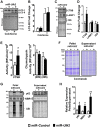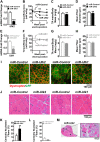ULK2 is essential for degradation of ubiquitinated protein aggregates and homeostasis in skeletal muscle
- PMID: 31361156
- PMCID: PMC6902739
- DOI: 10.1096/fj.201900766R
ULK2 is essential for degradation of ubiquitinated protein aggregates and homeostasis in skeletal muscle
Abstract
Basal protein turnover, which largely relies on the degradation of ubiquitinated substrates, is instrumental for maintenance of muscle mass and function. However, the regulation of ubiquitinated protein degradation in healthy, nonatrophying skeletal muscle is still evolving, and potential tissue-specific modulators remain unknown. Using an unbiased expression analysis of 34 putative autophagy genes across mouse tissues, we identified unc-51 like autophagy activating kinase (Ulk)2, a homolog of the yeast autophagy related protein 1, as particularly enriched in skeletal muscle. Subsequent experiments revealed accumulations of insoluble ubiquitinated protein aggregates associated with the adaptors sequestosome 1 (SQSTM1, also known as p62) and next to breast cancer type 1 susceptibility protein gene 1 protein (NBR1) in adult muscles with ULK2 deficiency. ULK2 deficiency also led to impaired muscle force and caused myofiber atrophy and degeneration. These features were not observed in muscles with deficiency of the ULK2 paralog, ULK1. Furthermore, short-term ULK2 deficiency did not impair autophagy initiation, autophagosome to lysosome fusion, or protease activities of the lysosome and proteasome. Altogether, our results indicate that skeletal muscle ULK2 has a unique role in basal selective protein degradation by stimulating the recognition and proteolytic sequestration of insoluble ubiquitinated protein aggregates associated with p62 and NBR1. These findings have potential implications for conditions of poor protein homeostasis in muscles as observed in several myopathies and aging.-Fuqua, J. D., Mere, C. P., Kronemberger, A., Blomme, J., Bae, D., Turner, K. D., Harris, M. P., Scudese, E., Edwards, M., Ebert, S. M., de Sousa, L. G. O., Bodine, S. C., Yang, L., Adams, C. M., Lira, V. A. ULK2 is essential for degradation of ubiquitinated protein aggregates and homeostasis in skeletal muscle.
Keywords: NBR1; ULK1; aggrephagy; autophagy; p62; proteostasis.
Conflict of interest statement
The authors acknowledge use of the University of Iowa Central Microscopy Research Facility, a core resource supported by the University of Iowa Vice President for Research, and the Carver College of Medicine. This study was supported by a Fraternal Order of Eagles Pilot Research Grant and American Heart Association Grant 16SDG30360001 (to V.A.L.). The authors declare no conflicts of interest.
Figures






Similar articles
-
The autophagy-inducing kinases, ULK1 and ULK2, regulate axon guidance in the developing mouse forebrain via a noncanonical pathway.Autophagy. 2018;14(5):796-811. doi: 10.1080/15548627.2017.1386820. Epub 2017 Dec 24. Autophagy. 2018. PMID: 29099309 Free PMC article.
-
Proteotoxic stress induces phosphorylation of p62/SQSTM1 by ULK1 to regulate selective autophagic clearance of protein aggregates.PLoS Genet. 2015 Feb 27;11(2):e1004987. doi: 10.1371/journal.pgen.1004987. eCollection 2015. PLoS Genet. 2015. PMID: 25723488 Free PMC article.
-
ER-Targeted Beclin 1 Supports Autophagosome Biogenesis in the Absence of ULK1 and ULK2 Kinases.Cells. 2019 May 17;8(5):475. doi: 10.3390/cells8050475. Cells. 2019. PMID: 31108943 Free PMC article.
-
Regulation of selective autophagy: the p62/SQSTM1 paradigm.Essays Biochem. 2017 Dec 12;61(6):609-624. doi: 10.1042/EBC20170035. Print 2017 Dec 12. Essays Biochem. 2017. PMID: 29233872 Review.
-
Oligomerization of Selective Autophagy Receptors for the Targeting and Degradation of Protein Aggregates.Cells. 2021 Aug 5;10(8):1989. doi: 10.3390/cells10081989. Cells. 2021. PMID: 34440758 Free PMC article. Review.
Cited by
-
CORP: Gene delivery into murine skeletal muscle using in vivo electroporation.J Appl Physiol (1985). 2022 Jul 1;133(1):41-59. doi: 10.1152/japplphysiol.00088.2022. Epub 2022 May 5. J Appl Physiol (1985). 2022. PMID: 35511722 Free PMC article. Review.
-
Autophagy in the Regulation of Tissue Differentiation and Homeostasis.Front Cell Dev Biol. 2020 Dec 10;8:602901. doi: 10.3389/fcell.2020.602901. eCollection 2020. Front Cell Dev Biol. 2020. PMID: 33363161 Free PMC article. Review.
-
Angiotensin-(1-7) Prevents Lipopolysaccharide-Induced Autophagy via the Mas Receptor in Skeletal Muscle.Int J Mol Sci. 2020 Dec 8;21(24):9344. doi: 10.3390/ijms21249344. Int J Mol Sci. 2020. PMID: 33302427 Free PMC article.
-
Impaired proteostatic mechanisms other than decreased protein synthesis limit old skeletal muscle recovery after disuse atrophy.J Cachexia Sarcopenia Muscle. 2023 Oct;14(5):2076-2089. doi: 10.1002/jcsm.13285. Epub 2023 Jul 14. J Cachexia Sarcopenia Muscle. 2023. PMID: 37448295 Free PMC article.
-
Effects of Combined Inorganic Nitrate and Nitrite Supplementation on Cardiorespiratory Fitness and Skeletal Muscle Oxidative Capacity in Type 2 Diabetes: A Pilot Randomized Controlled Trial.Nutrients. 2022 Oct 25;14(21):4479. doi: 10.3390/nu14214479. Nutrients. 2022. PMID: 36364742 Free PMC article. Clinical Trial.
References
-
- Visser M., Schaap L. A. (2011) Consequences of sarcopenia. Clin. Geriatr. Med. 27, 387–399 - PubMed
-
- Kamel H. K. (2003) Sarcopenia and aging. Nutr. Rev. 61, 157–167 - PubMed
-
- Walrand S., Guillet C., Salles J., Cano N., Boirie Y. (2011) Physiopathological mechanism of sarcopenia. Clin. Geriatr. Med. 27, 365–385 - PubMed
Publication types
MeSH terms
Substances
Grants and funding
LinkOut - more resources
Full Text Sources
Molecular Biology Databases
Research Materials

